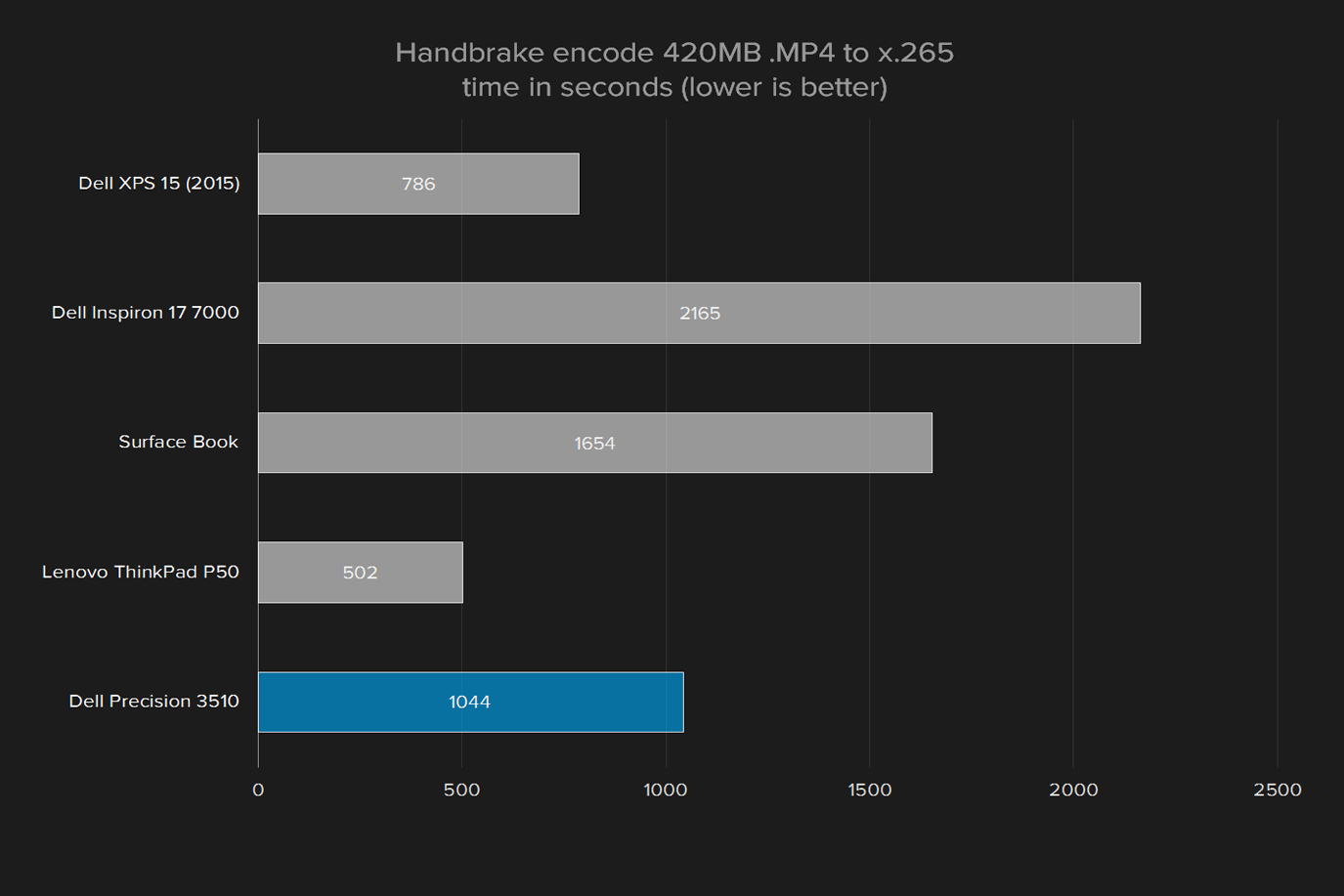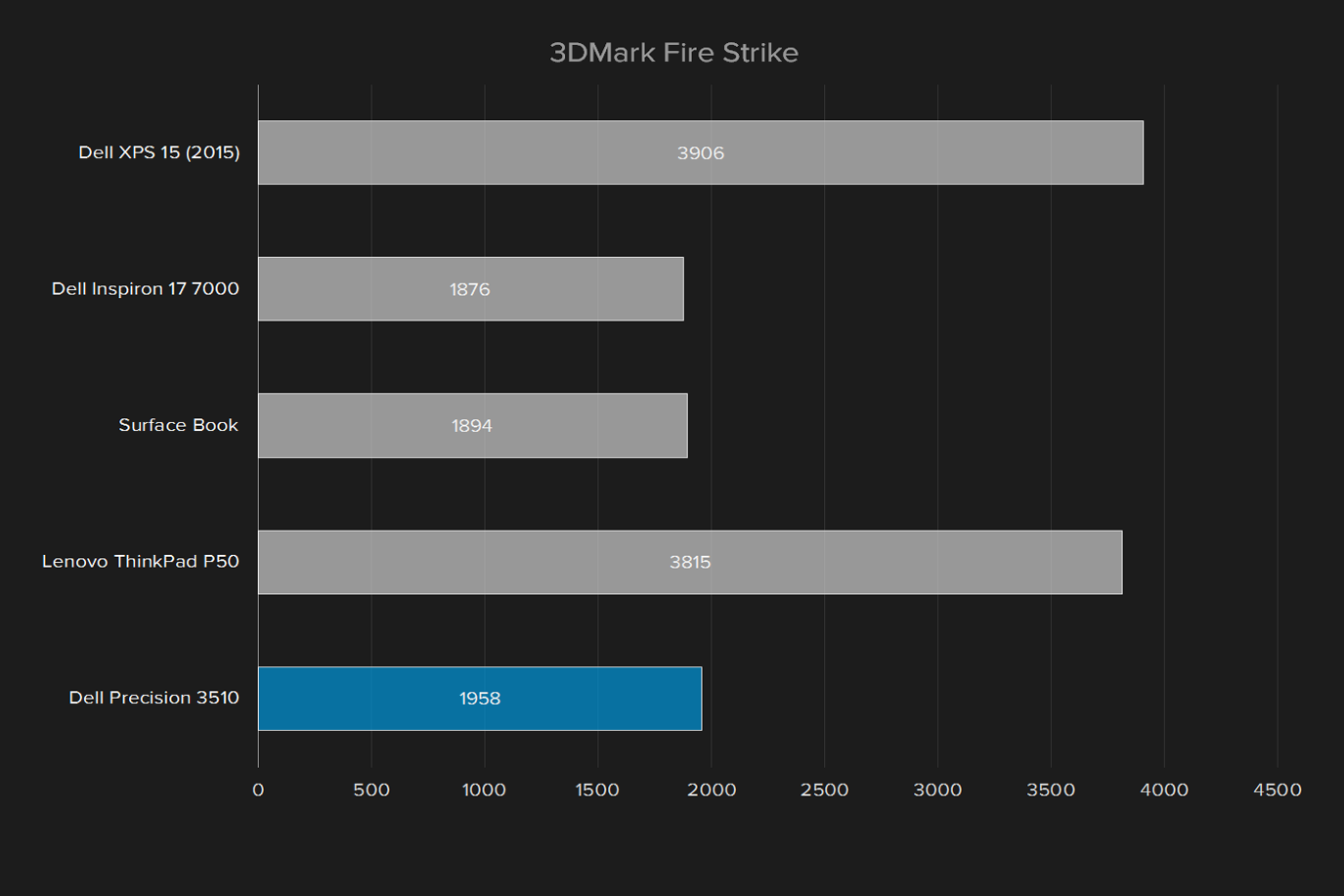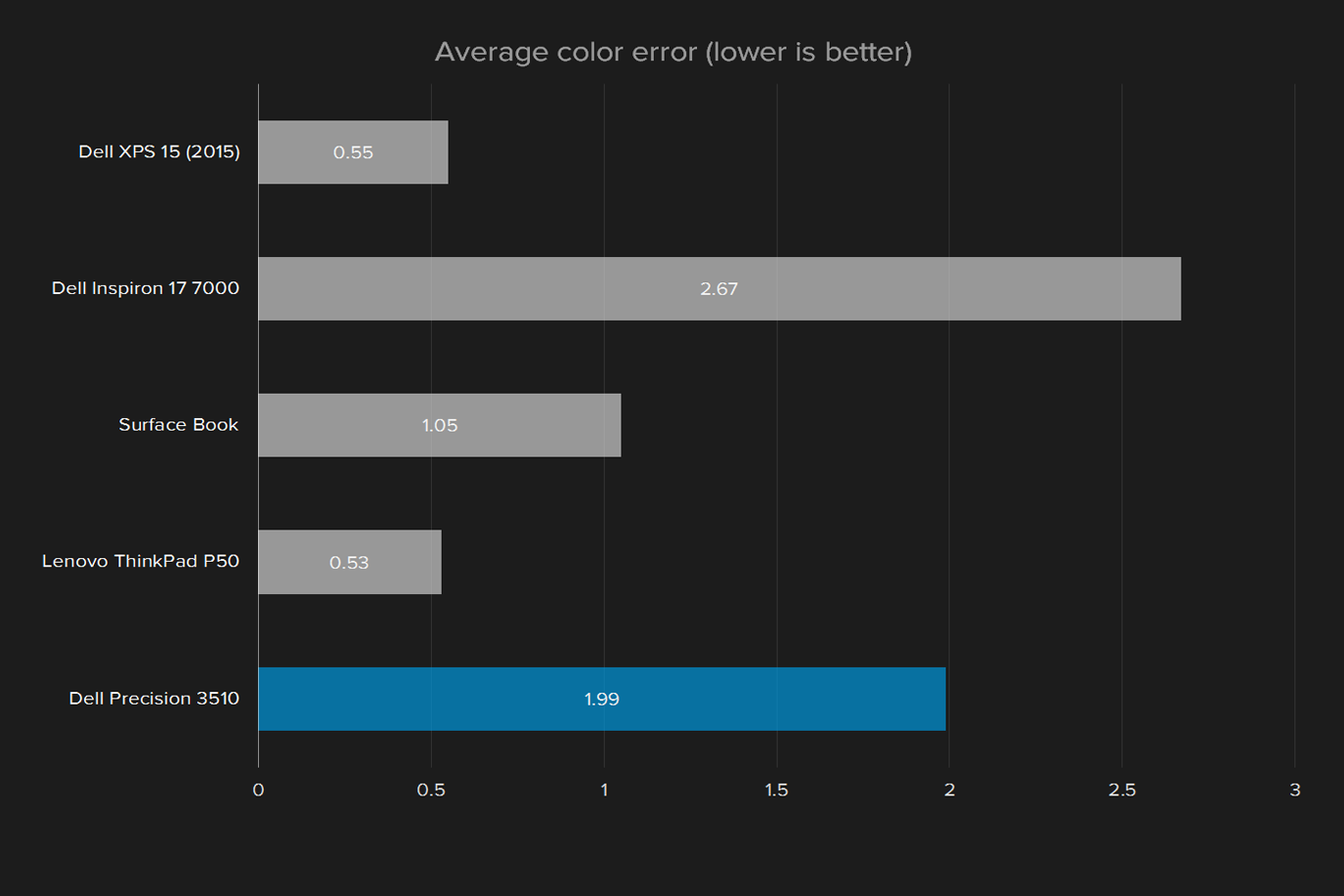- Comfortable keyboard with numeric keypad
- Plenty of connectivity
- High-end performance
- Great battery life
- Excellent standard warranty
- Mediocre display quality
- Display strangely has two bezels
- Heavy by contemporary standards
Lighter and thinner is the white whale of the laptop maker right now, unless you’re making business devices. While most contemporary laptop designs are obsessed with shedding pounds and inches, business-grade laptops like the Lenovo ThinkPad P50 ignore the zeitgeist and focus on power and ports instead.
Dell’s latest business laptop is the Precision 3510, a sturdy chunk of plastic with some serious internals. Our review unit came with an Intel i7-6820HQ processor, 16GB of memory, a full HD touchscreen, and a 256GB Samsung SM951 solid state drive. The additions bring the total up to $1,750, which is substantial. The i5 configuration starts at $1,000, and it’s not hard at all to spend upwards of $2,000.
Do the parts live up to the price? Or is this just an overpriced relic from another age, somehow still on the market? And either way, does this design live up to other business laptops on the market right now?
A sturdy black brick
Let’s get this out of the way quickly — this laptop is not lightweight, and it’s not thin. Large business laptops do not aim for that, and the Dell Precision 15 3510 is not an exception. It’s just under an inch thick when closed, and weighs nearly five pounds.
So no one would call this laptop elegant. But it’s definitely sturdy. It’s a brick. We couldn’t flex the lower case much when we tried, and though the display does visibly distort if you grip and twist both sides, it takes a lot of effort. The black plastic chassis has no give, and it feels great. There’s also plenty of grip on the bottom, so you’re not likely to drop the laptop.
Our only design complaint concerns the screen. This laptop has two bezels. There’s a black glass bezel surrounding the touchscreen, then a plastic bezel surrounding that. It’s an easy flaw to live with, but it looks out of place in a laptop priced close to $2,000.
Overall, though, this laptop boasts sturdy, no non-sense design, which is exactly what business customers are looking for.
Comfortable backlit keyboard
The keyboard on the Precision 3510 is generously sized and includes a numeric keypad. It also looks great, with crisp text on every key and attractive backlighting. The layout is normal, for the most part, though the Page Up and Page Down keys surround the Up arrow. This might strike some as odd, but it’s easy to adjust to.
And the keys themselves are a pleasure to use. There’s not a lot of travel, but every keystroke is crisp. There’s plenty of space between keys, meaning you’re likely to be accurate. It’s a very comfortable setup.
The touchpad is also good. It’s small compared to some laptops, but only because Dell left room for two rows of physical buttons below and above. And even within the limited space, the touchpad works well with multi-touch gestures. It feels smooth and responsive.
Some users will be delighted to know there’s a rubber “pointing stick” between the g, h, and b keys. This has been common on business-class laptops since IBM’s original ThinkPad. We actually think the rubbery texture here is a great improvement on the ThinkPad’s gritty design (though purists are free to disagree.) Cursor movement was very precise in our tests.
An extra $100 gets you a touchscreen, but we’re somewhat confounded as to why. There’s no wraparound hinge, and the 3510 is too heavy for tablet use in any case. Why would you want to reach across your keyboard and smudge up your screen? In any case, input was accurate, though the texture of the screen itself leaves something to be desired. Long, smooth movements can be tricky. We suggest you go without this particular option.
Connects to anything
If there’s one thing business laptops offer in spades, it’s ports.
The Dell Precision 15 3510 has three USB 3.0 ports, two on the right side and one on the back. There’s a Thunderbolt 3 port in the USB Type-C form factor. There’s an SD card reader and a MicroSD card reader.
This Dell can keep up with you, whatever it is you might do for work.
Basically, you can plug anything into this thing.
That includes just about any display in existence. The Thunderbolt 3 port works for brand-new displays, but Dell also offers full HDMI and a VGA port. Who needs dongles? There’s also a headphone jack.
Finally, we get to network connectivity. There’s a wired Ethernet port on the back and an Intel Dual-Band Wireless-AC 8260 card offering 802.11ac Wi-Fi and Bluetooth 4.1 support.
We’re surprised they didn’t throw in a serial port for good measure.
Great contrast, mediocre colors
The Dell Precision 15 3510 offers four different display choices. The cheapest configuration starts at 1,366 by 768 pixels. For $100 more, you can get a resolution of 1,920 by 1,080, or full HD. Add $100 on top of that and you get the touchscreen, which is what our review unit shipped with.
How did the most expensive display perform? The first thing we checked was the brightness, and our tests showed 322 lux. That’s approaching the high end of the market right now, and means that outside usage isn’t going to be much of a problem. At least, it wouldn’t be if not for the reflective touchscreen, which make usage in direct sunlight impractical.
The contrast ratio at full brightness was 680:1, which is pretty good. There are laptops with better quality, like the Microsoft Surface Book, which has a ratio of 1,410:1. But the Precision 3510 compares well to business-class competitors like the Lenovo ThinkPad P50, which reached a 700:1 ranking. Text looks crisp with this kind of contrast ratio, and it’s easy to make out shadows and nuance in photos.
Your computer will boot almost instantly, and programs load with similar speed.
The display is also perfectly respectable when it comes to color, though not exceptional. With 73 percent of the AdobeRGB standard, the Precision 3510 falls well short of the Thinkpad P50, which offers 96 percent of that same standard. This isn’t to say that 73 percent is bad: It’s typical in the broader laptop market. For a premium laptop, however, we’d like to see better results.
Color accuracy was also okay, but not great. We saw an average color error of 1.99, compared to the Ideapad P50’s 0.53 (lower is better). This also falls short of the similarly-priced Surface Book (1.05) and the Dell XPS 15 (1.99). Again, the Precision 15 3510’s result isn’t terrible, but it could be better.
In subjective use, the display’s mediocre qualities are hard to notice. While viewing a trailer for Wonder Woman, we noticed crisp image quality. The decent contrast ratio can provide a vibrant image with a good sense of depth. Colors sometimes looked muted, however, and the reflective screen was a problem when viewing dark scenes.
Work hard, play harder
Surprisingly, the speakers weren’t bad. A decent amount of bass gets through, for a laptop anyway, though treble can come out sounding a little tinny. But everything is clear, and you can make out dialogue from across the room clearly. External speakers are recommended as always, but the built in speakers are good enough for occasional usage.
A heaping serving of power
Our review unit came with an Intel Core i7-6820HQ processor and 16GB of memory, which is a lot of computing power. How does it stand up to usage?
Quite well, at least so far as our tests are concerned. Running Geekbench, we saw a single-core score of 3,434 and a multi-core score of 12,861. This is about what you should expect from such a powerful configuration, and closely matches other Core i7 laptops like the Dell XPS 15 and the ThinkPad P50. The multi-core score more than doubles dual-core competitors, like the Surface Book, which again is not surprising.
With this kind of power, day-to-day computing should never slow you down in the slightest. Hiccups just don’t happen.
Even demanding software runs without issue. We saw a 7-Zip compression benchmark combined score of 19,444, which beats both the Lenovo ThinkPad P50 and the Dell XPS 15. This means that number crunching of any kind will be speedy.
Bottom line, this is a very powerful laptop. You won’t experience problems during your workflow, whatever it is you might do for work.
Blazing fast solid state drive
Our review unit came with a 256GB Samsung SM951 solid state drive connected via PCI Express. That’s a decent amount of solid state storage, and if you need more, there’s up to a terabyte available on the Precision 3510’s configuration page. But how’s the speed?
Great. Our CrystalDiskMark results showed a read speed of 1,525 megabytes per second, and a write speed of 1,292MBps. That’s really fast, though slightly behind the Thinkpad P50’s results of 1,628MBps read and 1,537MBps write.
Still, the Precision 3510 does laps around laptops with SATA SSDs, like the Dell Inspiron 17 7000. There might be faster hard drives available, but this one is by no means going to hold you back. Your computer will boot almost instantly, and programs load with similar speed. Large files open within seconds, making this Dell a good candidate for editing huge photos or high-quality video.
Gaming is business too, right?
Our review unit shipped with AMD Firepro W5130M graphics, a dedicated solution designed with reliability and compute performance in mind. It’s a mid-range card, but it should offer a great deal more power than any laptop with on-board graphics.
And our tests showed that it does. The Precision 3510 scored 1,958 on the Fire Strike test in 3DMark, which closely matches laptops like the Surface Book and the Dell Inspiron 17 7000. This result falls well short of the Dell XPS 15 and Lenovo Thinkpad P50, however, both of which sport more powerful graphics cards.
With this kind of power, you can expect modern games to run well at low to medium settings. Actually firing up some games confirmed this.
Blizzard’s Heroes of the Storm, at its lowest settings, ran at 123 frames per second, which is buttery smooth. Crank the settings up to maximum, however, and you get 38 FPS, which is playable but not ideal. Counter Strike: Global Offensive was similar. On the lowest settings, we saw 106FPS; on the highest, 32FPS.
Basically, you can game on this laptop, if you’re willing to turn the settings down.
Expect to do some lifting
As we keep saying, portability was not a core design goal here. It shouldn’t surprise you to hear, then, that we didn’t love carrying it around. This laptop fit in a messenger bag without issue, but it became tiring, fast. Five pounds wasn’t a terribly heavy laptop a decade ago, but today it really stands out.
Even with its strong performance, battery life is amazing.
But all that weight pays off, because there’s plenty of power offered. Even better — all that power doesn’t drain the battery too quickly. Our Peacekeeper battery test showed five hours and 44 minutes of battery life. The Lenovo ThinkPad P50, for contrast, gave us just three hours and ten minutes during that same test.
Our web browser loop, where a collection of popular websites are loaded continuously, gave us five hours and fifty minutes of battery life, which suggests you can browse the web for quite a while on one charge. Watching movies is even better. Our video loop test gave us nine hours and 46 minutes of battery life.
Getting this kind of battery life with this kind of power is amazing. We’re willing to put up with the extra weight if that’s what it takes. Even if our sore shoulders temper our enthusiasm.
Getting hot in here
This kind of power requires some serious heat management, of course, and you’ll be hearing the fans. Still, they’re not too loud. The highest volume we could detect was 43.8 decibels, which was just barely louder than the ambient sound of our office.
Those fans seem to be doing their job, for the most part. The hottest temperature we could detect on the surface while running benchmarks was 124.7 degrees Fahrenheit. Oddly, the temperature was only in one place: the upper-left corner of the bottom of the laptop. The warmest temperature we found anywhere else was 103.1 degrees Fahrenheit.
That high temperature is in line with the Dell XPS 15, but a good 20 degrees hotter than most laptops we’ve reviewed recently. It’s not hot enough to be dangerous, but when you’ve got this laptop on your knees you’re going to notice it.
Choose your own operating system
When you order this Dell, you can choose between Windows 7, Windows 8.1, and Windows 10. Our review unit shipped with Windows 10, which ran very well with the hardware, but it’s nice for business users to have more options, especially in legacy IT environments.
Linux users will be pleased to know there’s a $100 discount available if you opt for Ubuntu 12.04, an ancient version of the most popular Linux distro. The Ubuntu site currently offers 16.04.1.
Warranty
The Dell Precision 15 3510 comes standard with three years of “pro support” and next day on-site service. That’s a very generous amount of coverage to begin with, but if you pay more you can tack on a few years and even accident coverage.
Powerful, but not pretty or cheap
If power is all that matters to you in a laptop, Dell offers a compelling package in the Precision 15 3510. It ignores the current obsession for portability and instead focuses on power, and the result is a no-nonsense laptop power users will love.
Our review rig cost $1,750, which isn’t exactly affordable, but considering the specs and the warranty it’s reasonable. This laptop isn’t a bargain, but it’s not overpriced either.
Does the Dell Precision 15 3510 beat the Lenovo ThinkPad P50? That depends what your priorities are. Dell offers much better battery life, and a more generous warranty, but Lenovo has the better display quality and the better graphics card. The P50 also looks and feels more worthy of its price tag, while the Dell makes a few missteps, like the strange bezel-within-a-bezel display.
If you’re in the market for a business-class laptop, the Dell Precision 15 3510 is well worth considering. It’s not cheap, and it’s not pretty, but it’s powerful and offers great battery life.





















